EXPRESSION TROPHOBLAST CELL B-CELL LYMPHOMA (BCL2) IN EARLY AND LATE-ONSET PREECLAMPSIA
Abstract
Background: Anti-apoptotic Bcl-2 has an important role that is involved in the regulation of apoptosis. Abnormal apoptotic activity in preeclampsia is caused by the dysregulation of these proteins. Trophoblast antiapoptotic and proapoptotic imbalance is thought to have different influences on the process of early-onset preeclampsia and late-onset preeclampsia
Objective: to analyze the difference in Bcl-2 expression in early and late-onset preeclampsia.
Method of study: This method was conducted using a cross-sectional study in early-onset preeclampsia compared to late-onset preeclampsia in RSUP. DR. Sardjito Yogyakarta was conducted from April 2019 to June 2019 with consecutive sampling methods. Placental tissue samples were obtained from 26 pregnancies with early-onset preeclampsia and 33 pregnancies with late-onset preeclampsia. The placental expression of Bcl-2 has been investigated by immunohistochemical staining and used semi-quantitative HSCORE examination.
Results: The T-test study showed there was a significant difference in Bcl-2 expression among early onset preeclampsia (2.31±0.66 ) and late-onset preeclampsia (2.61±0.43) with p-value 0.047 (p<0.05). Bcl-2
the expression appears lower in early-onset preeclampsia with a mean value of 0.30 (CI 0.04 – 0.60).
Conclusion: Thus we can conclude the expression of Bcl-2 is considered lower in early-onset preeclampsia compared to late-onset preeclampsia
References
Aksornphusitaphong, A.P.2013. Risk factors of early and late-onset pre-eclampsia J Obstet Gynaecol Res. 39(3):627-31.
Aouache,R., Biquard, L., Vaiman, D., Miralles, F. 2018. Oxidative Stress in Preeclampsia and Placental Diseases. Int J Mol Sci. 17(19).
Arianto, B., Hadiati, D.R., Nurdiati, D.S. 2015. Perbandingan Rerata Ekspresi Bcl-2 Dan Bcl-Xl Pada Preeklamsia Berat Dan Kehamilan Normotensi. Jurnal Kesehatan Reproduksi. 2(2).
Cali, U., Cavkaytar, S., Sirvan, L., Danisman, N. 2013. Placental apoptosis in preeclampsia, intrauterine growth retardation, and HELLP syndrome: an immunohistochemical study with caspase-3 and bcl-2. Clin Exp Obstet Gynecol. 40(1):45-8.
Cunningham, F.G., Leveno, K.J., Bloom, S., Hauth, J.C., Rouse, D., Spong, C. 2014. Pregnancy Hypertension. Williams Obstetrics. 24th ed. United States of America: McGraw Hill Medical Companies; p. 728.
Dinas Kesehatan Jawa Tengah. 2016. Profil Kesehatan Jawa Tengah 2015.
Dinas Kesehatan Jawa Timur. 2016. Profil Kesehatan Jawa Timur 2015.
Holland, O.J., Cuffe, J.S.M., Dekker, N. M., Callaway, L., Kwan Cheung, K.A., Radenkovic, F., et al. 2018. Placental mitochondrial adaptations in preeclampsia associated with progression to term delivery. Cell Death Dis. 9(12):1150.
Huppertz, B. 2008.Placental origins of preeclampsia: challenging the current hypothesis. Hypertension. 51(4):970-5.
Lacobelli,S., Bonsante, F., Robillard, P.Y. 2017. Comparison of risk factors and perinatal outcomes in early-onset and late-onset preeclampsia: A cohort-based study in Reunion Island. J Reprod Immunol. 123:12-6.
Lisonkova, S., Joseph, K.S. 2013. Incidence of preeclampsia: risk factors and outcomes associated with early- versus late-onset disease. Am J Obstet Gynecol. 209(6):544 e1- e12.
Medvedev, B.I., Syundyukova, E.G., Sashenkov, S.L. 2016. Markers of cell renewal in the placenta in early- and late-onset preeclampsia. Gynecology, Obstetrics, and Perinatology. 15(4):31-6.
Roberts, J.M., & Escudero, C. 2012. The placenta in preeclampsia. Pregnancy Hypertension: An International Journal of Women's Cardiovascular Health. 2(2):72-83.
Shu-Han You, Po-Jen, C., Ting-Ting, C., Chang-Fu, K., Hsien-Ming, W., Chu, P.H. 2018. Population-based trends and risk factors of early- and late-onset preeclampsia in Taiwan 2001–2014. BMC Pregnancy and Childbirth.18:199.
Straszewski-Chavez, S.L, Abrahams, V.M, Mor, G. 2005. The role of apoptosis in the regulation of trophoblast survival and differentiation during pregnancy. Endocr Rev. 26(7):877-97.
Valensise, H., Vasapollo, B., Gagliardi, G., Novelli, G.P. 2008. Early and late preeclampsia: two different maternal hemodynamic states in the latent phase of the disease. Hypertension.52(5):873-80.
Vasilii, C., Boris, M., Elena, S., Sergei, S. 2017. Cell renovation markers, apoptotic markers and placental expression of erythropoietin in preeclampsia. Pregnancy Hypertension: An International Journal of Women’s Cardiovascular Health.9:36-63.
Vavina, O.V., Khodzhaeva, K.Z., Vyssokikh, M.Yu., Klimenchenko, N.I., Muminova, K.T., Tarasova, N.V., et al. 2016. Profound mitochondrial dysfunction leads to early onset preeclampsia. European Journal of Obstetrics & Gynecology and Reproductive Biology. 206( e1–e127).

This work is licensed under a Creative Commons Attribution-NonCommercial-ShareAlike 4.0 International License.






